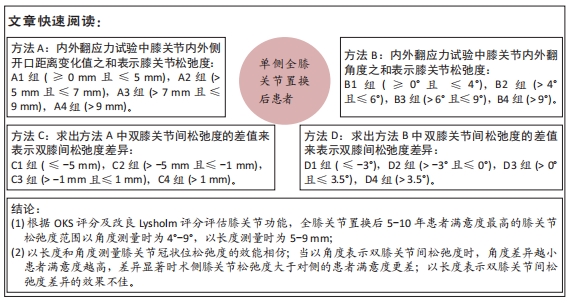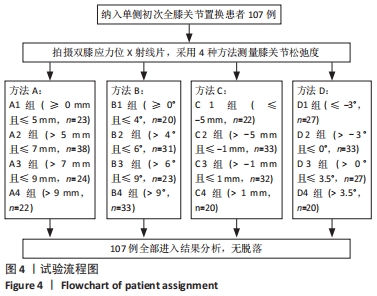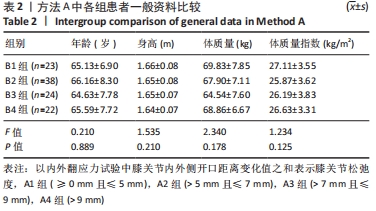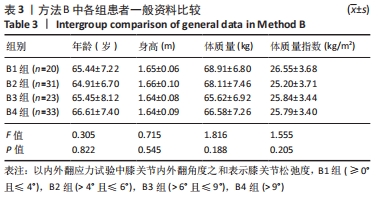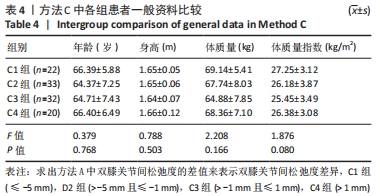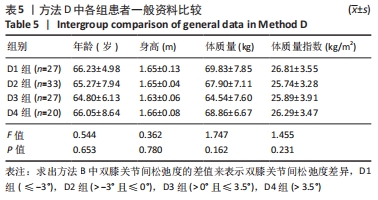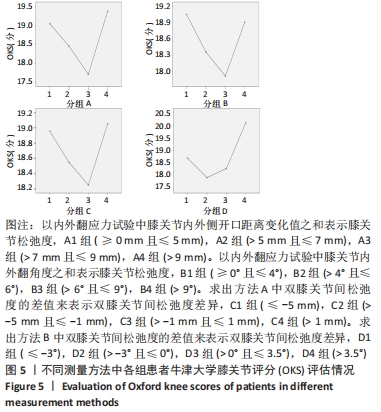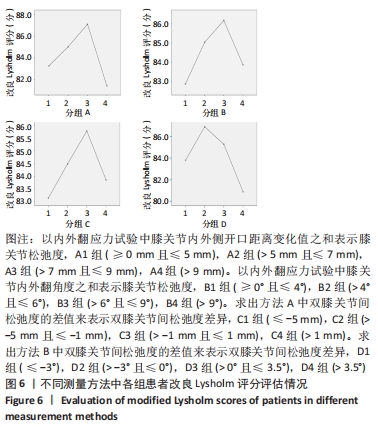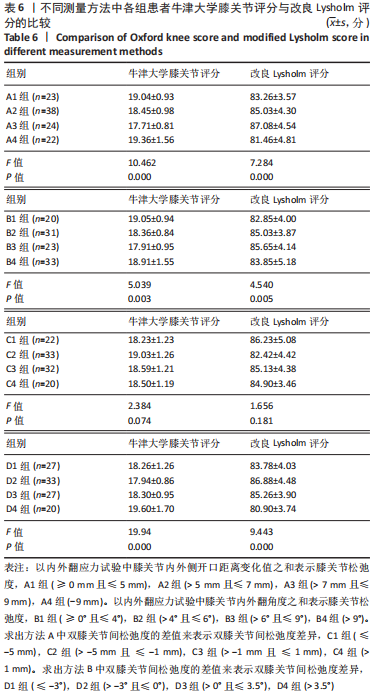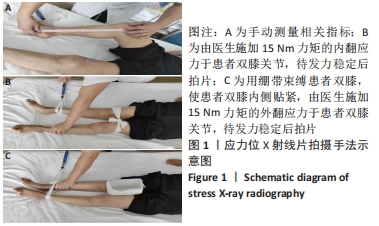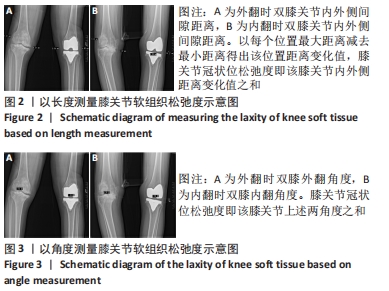[1] JASPER LL, JONES CA, MOLLINS J, et al. Risk factors for revision of total knee arthroplasty: a scoping review. BMC Musculoskelet Disord. 2016;17:182.
[2] LÜRING C, BECKMANN J. Custom made total knee arthroplasty : Review of current literature. Orthopade. 2020;49(5):382-389.
[3] SEO SS, NHA KW, KIM TY, et al. Survival of total knee arthroplasty after high tibial osteotomy versus primary total knee arthroplasty: A meta-analysis. Medicine (Baltimore). 2019;98(30):e16609.
[4] WANG Z, CHENG X, ZHANG Y, et al. Restoration of Constitutional Alignment in TKA with a Novel Osteotomy Technique. J Knee Surg. 2020;33(2):190-199.
[5] BLAKENEY W, BEAULIEU Y, PULIERO B, et al. Bone resection for mechanically aligned total knee arthroplasty creates frequent gap modifications and imbalances. Knee Surg Sports Traumatol Arthrosc. 2020;28(5):1532-1541.
[6] SASAKI S, SASAKI E, KIMURA Y, et al. Effect of medial collateral ligament release and osteophyte resection on medial laxity in total knee arthroplasty. Knee Surg Sports Traumatol Arthrosc. 2020. doi: 10.1007/s00167-020-06257-1.
[7] ASANO H, MUNETA T, SEKIYA I. Soft tissue tension in extension in total knee arthroplasty affects postoperative knee extension and stability. Knee Surg Sports Traumatol Arthrosc. 2008;16(11):999-1003.
[8] PAXTON EW, FURNES O, NAMBA RS, et al. Comparison of the Norwegian knee arthroplasty register and a United States arthroplasty registry. J Bone Joint Surg Am. 2011;93 Suppl 3:20-30.
[9] KAPPEL A, LAURSEN M, NIELSEN PT, et al. Relationship between outcome scores and knee laxity following total knee arthroplasty: a systematic review. Acta Orthop. 2019;90(1):46-52.
[10] OH CS, SONG EK, SEON JK, et al. The effect of flexion balance on functional outcomes in cruciate-retaining total knee arthroplasty. Arch Orthop Trauma Surg0 2015;135(3):401-406.
[11] LEE BS, CHO HI, BIN SI, et al. Femoral Component Varus Malposition is Associated with Tibial Aseptic Loosening After TKA. Clin Orthop Relat Res0 2018;476(2):400-407.
[12] SEON JK, SONG EK, YOON TR, et al. In vivo stability of total knee arthroplasty using a navigation system. Int Orthop. 2007;31(1):45-48.
[13] Aunan E, Kibsgård TJ, Diep LM, et al. Intraoperative ligament laxity influences functional outcome 1 year after total knee arthroplasty. Knee Surg Sports Traumatol Arthrosc 2015;23(6):1684-1692
[14] ALTMAN R, ASCH E, BLOCH D, et al. Development of criteria for the classification and reporting of osteoarthritis. Classification of osteoarthritis of the knee. Diagnostic and Therapeutic Criteria Committee of the American Rheumatism Association. Arthritis Rheum. 1986;29(8):1039-1049.
[15] SIONG FT, KIM TW, KIM SC, et al. Efficacy and Safety of Functional Medial Ligament Balancing With Stepwise Multiple Needle Puncturing in Varus Total Knee Arthroplasty. J Arthroplasty. 2020;35(2):380-387.
[16] LAPRADE RF, HEIKES C, BAKKER AJ, et al. The reproducibility and repeatability of varus stress radiographs in the assessment of isolated fibular collateral ligament and grade-III posterolateral knee injuries. An in vitro biomechanical study. J Bone Joint Surg Am. 2008;90(10):2069-2076.
[17] KANE PW, DEPHILLIPO NN, CINQUE ME, et al. Increased Accuracy of Varus Stress Radiographs Versus Magnetic Resonance Imaging in Diagnosing Fibular Collateral Ligament Grade III Tears. Arthroscopy. 2018;34(7):2230-2235.
[18] MURER M, FALKOWSKI AL, HIRSCHMANN A, et al. Threshold values for stress radiographs in unstable knees after total knee arthroplasty. Knee Surg Sports Traumatol Arthrosc. 2021;29(2):422-428.
[19] DEPHILLIPO NN, KANE PW, ENGEBRETSEN L. Stress Radiographs for Ligamentous Knee Injuries. Arthroscopy. 2021;37(1):15-16.
[20] GOH GS, BIN ABD RAZAK HR, TAY DK, et al. Early post-operative oxford knee score and knee society score predict patient satisfaction 2 years after total knee arthroplasty. Arch Orthop Trauma Surg. 2021;141(1):129-137.
[21] JEONG HS, LEE SC, JEE H, et al. Proprioceptive Training and Outcomes of Patients With Knee Osteoarthritis: A Meta-Analysis of Randomized Controlled Trials. J Athl Train. 2019;54(4):418-428.
[22] LIN K, BAO L, WANG J, et al. Validation of the Chinese (Mandarin) Version of the Oxford Knee Score in Patients with Knee Osteoarthritis. Clin Orthop Relat Res. 2017;475(12):2992-3004.
[23] SUEYOSHI T, EMOTO G, YATO T. Correlation between Single Assessment Numerical Evaluation score and Lysholm score in primary total knee arthroplasty patients. Arthroplast Today. 2018;4(1):99-102.
[24] BRIGGS KK, STEADMAN JR, HAY CJ, et al. Lysholm score and Tegner activity level in individuals with normal knees. Am J Sports Med. 2009;37(5):898-901.
[25] BELLEMANS J, VANDENNEUCKER H, VAN LAUWE J, et al. A new surgical technique for medial collateral ligament balancing: multiple needle puncturing. J Arthroplasty. 2010;25(7):1151-1156.
[26] SINICROPE BJ, FEHER AW, BHIMANI SJ, et al. Increased Survivorship of Cementless versus Cemented TKA in the Morbidly Obese. A Minimum 5-Year Follow-Up. J Arthroplasty. 2019;34(2):309-314.
[27] MONTONEN E, LAAKSONEN I, MATILAINEN M, et al. What Is the Long-term Survivorship of Cruciate-retaining TKA in the Finnish Registry. Clin Orthop Relat Res. 2018;476(6):1205-1211.
[28] Courtney PM, Lee GC. Early Outcomes of Kinematic Alignment in Primary Total Knee Arthroplasty: A Meta-Analysis of the Literature. J Arthroplasty 2017;32(6):2028-2032.e1
[29] YONG TM, YOUNG EC, MOLLOY IB, et al. Long-Term Implant Survivorship and Modes of Failure in Simultaneous Concurrent Bilateral Total Knee Arthroplasty. J Arthroplasty. 2020;35(1):139-144.
[30] KUSTER MS, BITSCHNAU B, VOTRUBA T. Influence of collateral ligament laxity on patient satisfaction after total knee arthroplasty: a comparative bilateral study. Arch Orthop Trauma Surg. 2004;124(6):415-417.
[31] YAMAKADO K, KITAOKA K, YAMADA H, et al. Influence of stability on range of motion after cruciate-retaining TKA. Arch Orthop Trauma Surg. 2003; 123(1):1-4.
[32] NAKAHARA H, OKAZAKI K, HAMAI S, et al. Does knee stability in the coronal plane in extension affect function and outcome after total knee arthroplasty. Knee Surg Sports Traumatol Arthrosc. 2015;23(6):1693-1698.
[33] ARIRACHAKARAN A, CHOOWIT P, PUTANANON C, et al. Is unicompartmental knee arthroplasty (UKA) superior to total knee arthroplasty (TKA)? A systematic review and meta-analysis of randomized controlled trial. Eur J Orthop Surg Traumatol. 2015;25(5):799-806.
[34] RUTHERFORD RW, JENNINGS JM, LEVY DL, et al. Revision Total Knee Arthroplasty for Arthrofibrosis. J Arthroplasty. 2018;33(7S):S177-S181.
[35] BADE MJ, STRUESSEL T, DAYTON M, et al. Early High-Intensity Versus Low-Intensity Rehabilitation After Total Knee Arthroplasty: A Randomized Controlled Trial. Arthritis Care Res (Hoboken). 2017;69(9):1360-1368.
[36] WALKER LC, CLEMENT ND, DEEHAN DJ. Predicting the Outcome of Total Knee Arthroplasty Using the WOMAC Score: A Review of the Literature. J Knee Surg. 2019;32(8):736-741.
|
